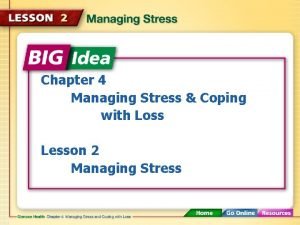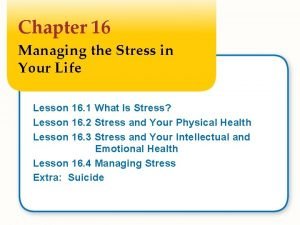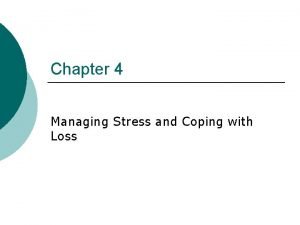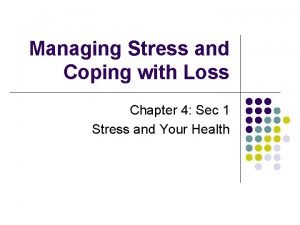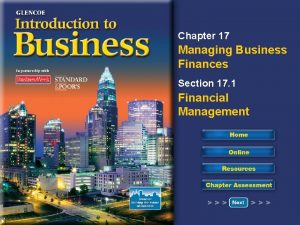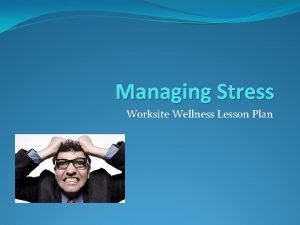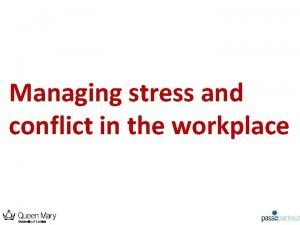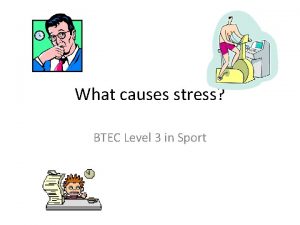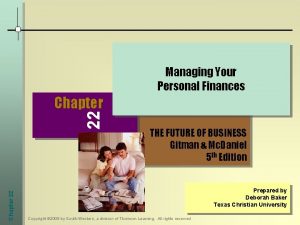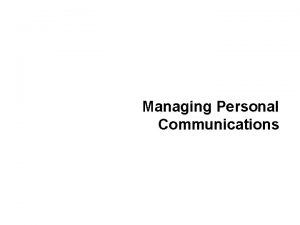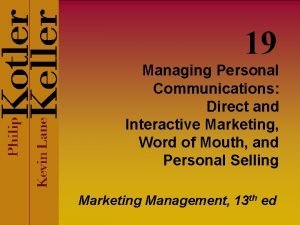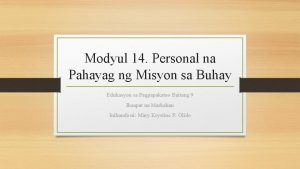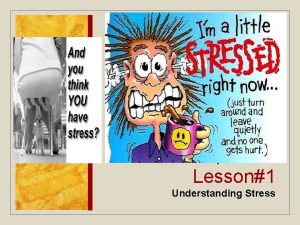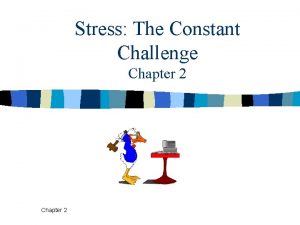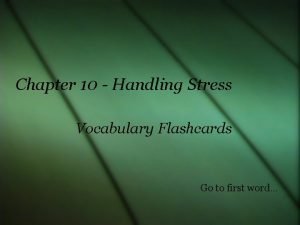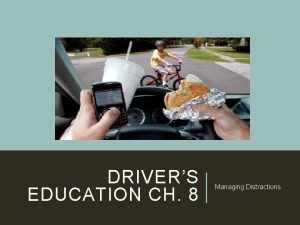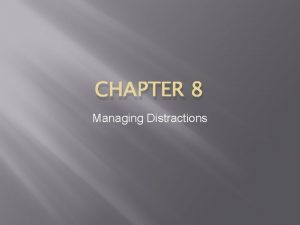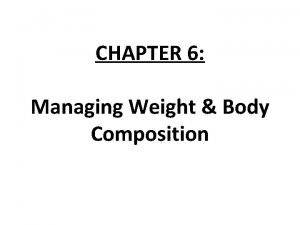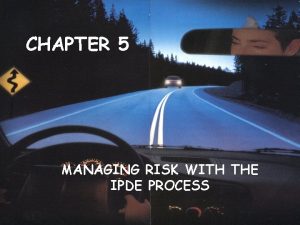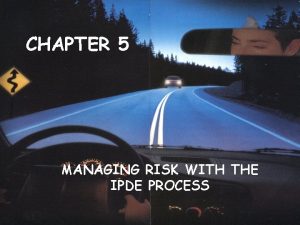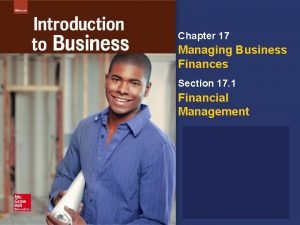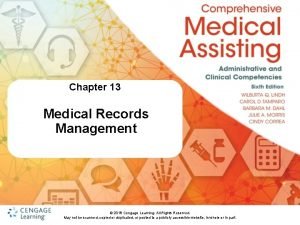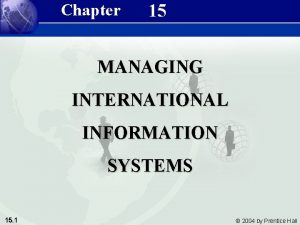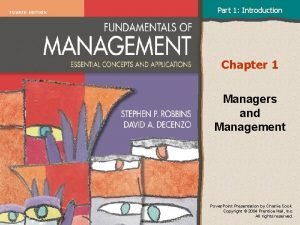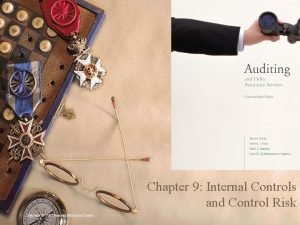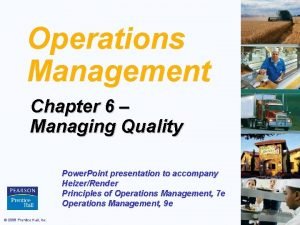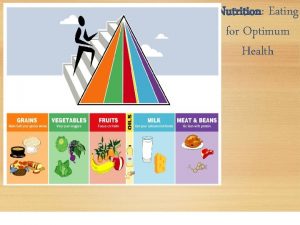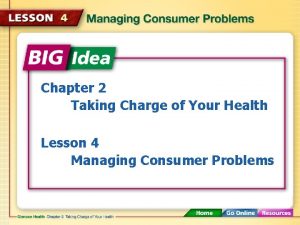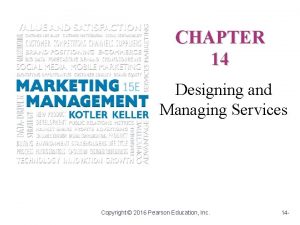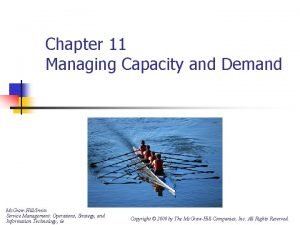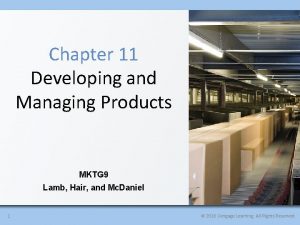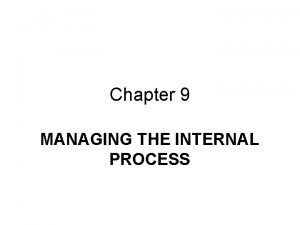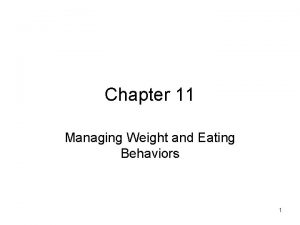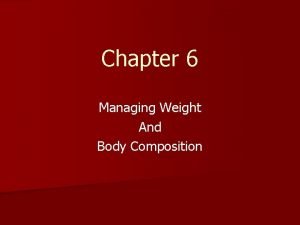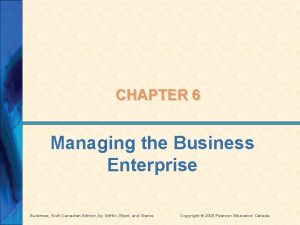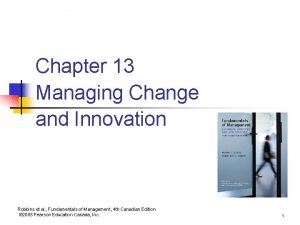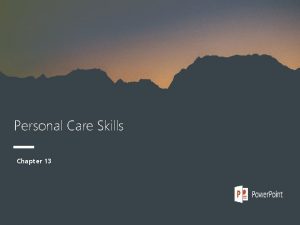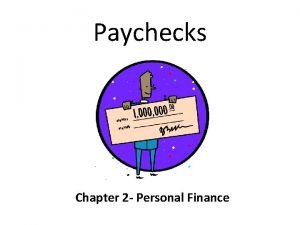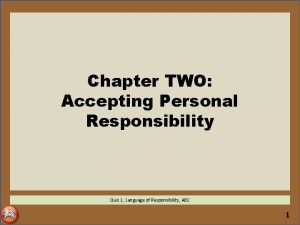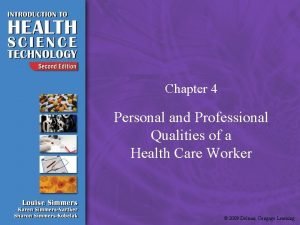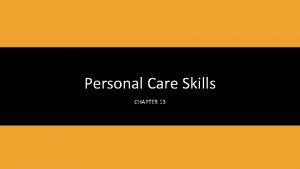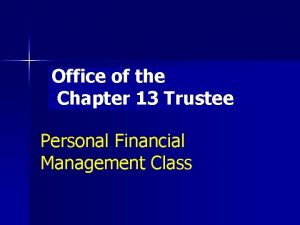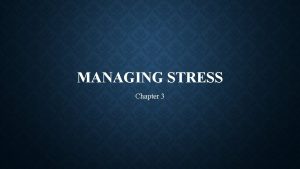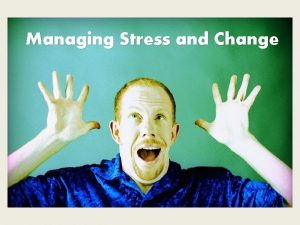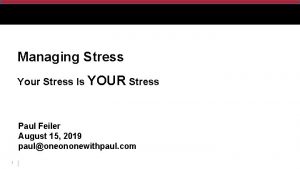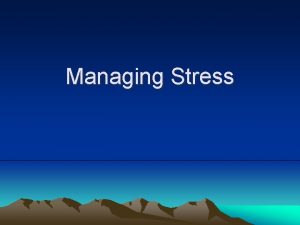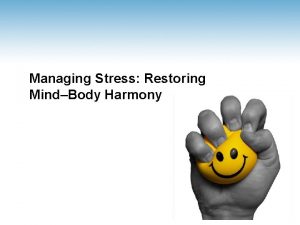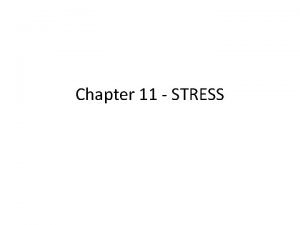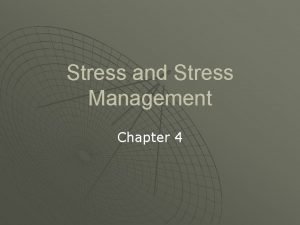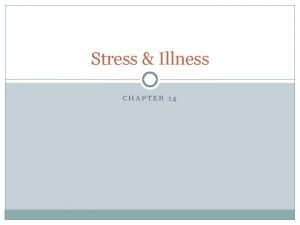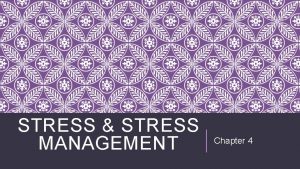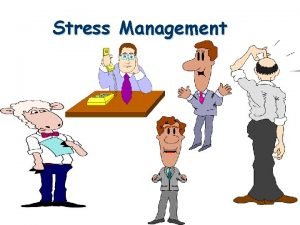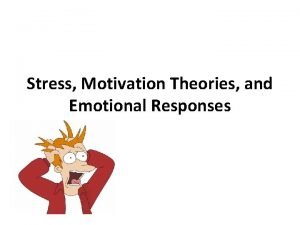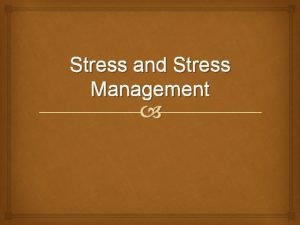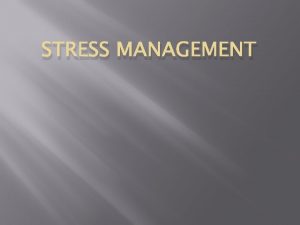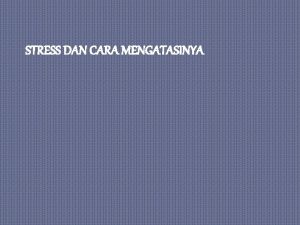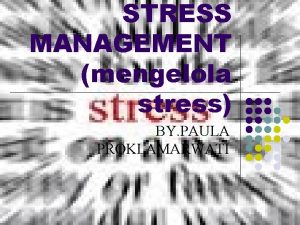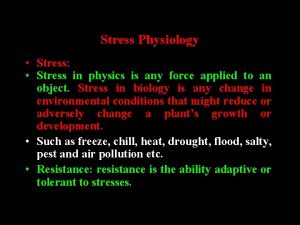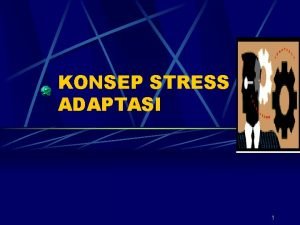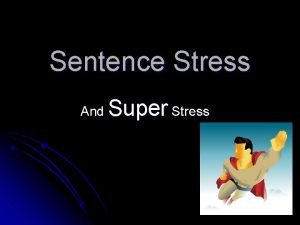Chapter 2 Managing Personal Stress Ch 2 Managing








































































- Slides: 72

Chapter 2. Managing Personal Stress Ch 2. Managing Personal Stress 1

Diagnostic Surveys For Managing Stress Management Assessment: Your answer should reflect your attitudes and behavior as they are now, not at you would like them to be. Be honest. This instrument is designed to help you discover your level of competency in stress management. Ch 2. Managing Personal Stress 2

Diagnostic Surveys For Managing Stress Management Assessment (continued): Rating scale: 1 = strongly disagree 2 = disagree 3 = slightly disagree 4 = slightly agree 5 = agree 6 = strongly agree Ch 2. Managing Personal Stress 3

1. I use effective management methods such as keeping track of my time, making to do list, and prioritizing tasks. 2. I maintain a program of regular exercise for fitness. Ch 2. Managing Personal Stress 4

3. I maintain an open, trusting relationship with someone with whom I can share my frustrations. 4. I know and practice several temporary relaxation techniques such as deep breathing and muscle relaxation. Ch 2. Managing Personal Stress 5

5. I frequently affirm my priorities so that less important thing don’t drive out more important things. 6. I maintain balance in my life by pursuing a variety of interests outside of work. Ch 2. Managing Personal Stress 6

7. I have a close relationship with someone who serves as my mentor or advisor. 8. I effectively utilize others in accomplishing work assignments. Ch 2. Managing Personal Stress 7

9. I encourage others to generate recommended solutions, not just questions, when they come to me with problems or issues. 10. I strive to redefine problems as opportunities for improvement. Ch 2. Managing Personal Stress 8

Time Management Assessment (Page 107) Frequency with which you do each activity. Fill in each blank with the number from the rating scale. 0 = never 1 = seldom 2 = sometimes 3 = usually 4 = always Asses your behavior as it is, not as you would like it to be. Ch 2. Managing Personal Stress 9

Time Management Assessment (Page 107) 1. I read selectively, skimming the material until I find what is important, then highlighting it. 2. I make a list of tasks to accomplish each day. Ch 2. Managing Personal Stress 10

Time Management Assessment (Page 107) 3. I keep everything in its proper place at work. 4. I prioritize the tasks I have to do according to their importance and urgency. Ch 2. Managing Personal Stress 11

Time Management Assessment (Page 107) 5. I concentrate on only one important task at a time, but I do multiple trivial tasks at once (such as signing letters while talking on the phone). 6. I make a list of short five or ten minute tasks to do. Ch 2. Managing Personal Stress 12

Time Management Assessment (Page 107) 7. I divide large projects into smaller, separate stages. 8. I identify which 20 percent of may tasks will produce 80 percent of the results. Ch 2. Managing Personal Stress 13

Time Management Assessment (Page 107) 9. I do the most important tasks at my best time during the day. 10. I have some time during each day when I can work uninterrupted. Ch 2. Managing Personal Stress 14

Time Management Assessment (Page 107) 11. I don’t procrastinate. I do today what needs to be done. 12. I keep track of the use of my time with devices such as time log. Ch 2. Managing Personal Stress 15

Time Management Assessment (Page 107) 13. I set deadline for myself. 14. I do something productive whenever I am waiting. 15. I do redundant “busy work” at one set time during the day. 16. I finish at least one thing every day. Ch 2. Managing Personal Stress 16

Time Management Assessment (Page 107) 17. I schedule sometime during the day for personal time alone (for planning, meditation, prayer, exercise). 18. I allow myself to worry about things only at one particular time during the day, not all time. Ch 2. Managing Personal Stress 17

Time Management Assessment (Page 107) 19. I have clearly defined long term objectives toward which I am working. 20. I continually try to find little ways to use my time more efficiently. Ch 2. Managing Personal Stress 18

Time Management Assessment (Page 107) Comparison data: n = 1500 students Mean score Top quartile Third quartile Second quartile Bottom quartile : 92 : 108 or above : 93 -107 : 78 -92 : 77 or below Ch 2. Managing Personal Stress 19

Type A Personality Inventory (Page 108 -109) Rate the extent to which each of the following statement is typical of your most of the time. Focus on your general way of behaving and feeling. There are no right or wrong answers. Ch 2. Managing Personal Stress 20

Type A Personality Inventory (Page 108 -109) Rating scale: 3 = the statement is very typical of me. 2 = the statement is somewhat typical of me. 1 = the statement is not at all typical of me. Ch 2. Managing Personal Stress 21

Type A Personality Inventory (Page 108 -109) 1. My greatest satisfaction comes from doing things better than others. 2. I tend to bring theme of a conversation around to things I am interested in 3. In conversation, I frequently clench my fist, bang on the table, or pond one fist into the palm of another for emphasis. Ch 2. Managing Personal Stress 22

Type A Personality Inventory (Page 108 -109) 4. I move, walk, and eat rapidly. 5. I feel as though I can accomplish more than others. 6. I feel guilty when I relax or do nothing for several hours or days. 7. It does not take much to get me to argue. Ch 2. Managing Personal Stress 23

Type A Personality Inventory (Page 108 -109) 8. I feel impatient with the rate at which most events take place. 9. Having more than others is important to me. 10. One aspect of my life (e. g. , work, family care, school) dominates all others. 11. I frequently regret not being able to control my temper. Ch 2. Managing Personal Stress 24

Type A Personality Inventory (Page 108 -109) 12. I hurry the speech of others by saying “ Uh Huh”, “Yes, Yes”, or by finishing their sentences for them. 13. People who avoid competition have low self confidence. 14. To do something well, you have to concentrate on it alone and screen out all distractions. 15. I feel other’s mistakes and errors cause me needless aggravation. Ch 2. Managing Personal Stress 25

Type A Personality Inventory (Page 108 -109) 16. I find it intolerable to watch others perform tasks I know I can do faster. 17. Getting ahead in my job is a major personal goal. 18. I simply do not have enough time to lead a well balanced life. 19. I take out my frustration with my own imperfections on others. Ch 2. Managing Personal Stress 26

Type A Personality Inventory (Page 108 -109) 20. I frequently try to do two or more things simultaneously. 21. When I encounter a competitive person, I feel a need to challenge him or her. 22. I tent to fill up my spare time with thoughts and activities related to my work (or school or family care). 23. I am frequently upset by the unfairness of life. 24. I find it anguishing to wait in line. Ch 2. Managing Personal Stress 27

Type A Personality Inventory (Page 108 -109) Scoring key: The type a personality inventory costs of four behavioral tendencies: 1. Extreme competitiveness. 2. High work involvement. 3. Strong feelings of hostility and anger. 4. Extreme sense of urgency and impatience. Score above 12 in each area suggest that you have pronounced tendency. Ch 2. Managing Personal Stress 28

Type A Personality Inventory (Page 108 -109) Competitiveness Item Score 1 5 9 13 17 21 Total Ch 2. Managing Personal Stress 29

Type A Personality Inventory (Page 108 -109) Work Involvement Item Score 2 6 10 14 18 22 Total Ch 2. Managing Personal Stress 30

Type A Personality Inventory (Page 108 -109) Hostility/Anger Item Score 3 7 11 15 19 23 Total Ch 2. Managing Personal Stress 31

Type A Personality Inventory (Page 108 -109) Impatience/Urgency Item Score 4 8 12 16 20 24 Total Ch 2. Managing Personal Stress 32

Improving the Management of Stress and Time Managing time and stress is one of the most crucial, yet neglected, management skills in a competent manager’s. Ch 2. Managing Personal Stress 33

Improving the Management of Stress and Time (continued) Stress can produce devastating effects, such as: - inability to concentrate, - anxiety, - depression to stomach disorders, - low resistance to illness, - heart disease. - negative physiological, - negative psychological, - negative social reactions. Ch 2. Managing Personal Stress 34

The Role of Management When managers experience stress, they tend to: - Selectively perceive information and see only that which confirms their previous biases. - Become very intolerant of ambiguity and demanding of right answer. - Consult and listen to others less. - Etc. Ch 2. Managing Personal Stress 35

Major Elements of Stress produces positive as well as negative effects. In the absence of any stress, people feel completely bored and lack any inclination to act. Ch 2. Managing Personal Stress 36

Reactions to Stress: 1. Aggression, involves attacking the stressor directly. May involve attacking oneself, other people, or even objects. Ch 2. Managing Personal Stress 37

Reactions to Stress: 2. Regression, the adoption of a behavior pattern or response that was successful at some earlier time (responding in childish ways). Ch 2. Managing Personal Stress 38

Reactions to Stress: 3. Repression, involves denial of the stressor, forgetting, or redefining the stressor (ex: deciding that it is not so scary after all). Ch 2. Managing Personal Stress 39

Reactions to Stress: 4. Withdrawal, individuals may engage in fantasy, inattention, or purposive forgetting, or they may actually escape from the situation itself. Ch 2. Managing Personal Stress 40

Reactions to Stress: 5. Fixation, Which is persisting in a response regardless of its effectiveness (ex: repeatedly and rapidly redialing a telephone number when it is busy). Ch 2. Managing Personal Stress 41

Coping With Stress: 1. Enactive strategies, create or enact a new environment for the individual that does not contain the stressor. 2. Proactive strategies, to initiate action that resists the negative effect of stress. 3. Reactive strategies, applied as on the spot remedies to reduce temporarily the effect of stress. Ch 2. Managing Personal Stress 42

Coping with Stress: Enactive Strategies Proactive Strategies Reactive Strategies Purpose Eliminate Stressors Develop Resiliency Strategies Learn Temporary Coping Mechanism Effects Permanent Long Term Short Term Approach Enactive Proactive Reactive Time Required Long Time Moderate Time Immediate Ch 2. Managing Personal Stress 43

Managing Stress (Stressors: ) Four key sources of stress: 1. Time stressors. 2. Encounter stressors. 3. Situational stressors. 4. Anticipatory stressors. Ch 2. Managing Personal Stress 44

Managing Stress (Stressors: ) (continued) 1. Time stressors, generally results from having too much to do in too little time. Work overload, Lack of control, There is significant relationship between the presence of time stressors and job dissatisfaction, tension, perceived threat, heart rate, cholesterol levels, skin resistance. Ch 2. Managing Personal Stress 45

Managing Stress (Stressors: ) (continued) 1. Time stressors (continued), The presence of temporary time stressors may serve as motivators for getting work done. However, a constant state of time pressure, having too much to do and not enough time to do it, is usually harmful. Ch 2. Managing Personal Stress 46

Managing Stress (Stressors: ) (continued) 2. Encounter stressors, * Result from interpersonal interactions. * Common for managers. * Generally arise from three types of conflicts: 1. Role conflicts 2. Issue conflicts 3. Action conflicts Ch 2. Managing Personal Stress 47

Managing Stress (Stressors: ) (continued) 2. Encounter stressors (continued), Role conflicts, In which roles performed by group members are incompatible. Issue conflicts, In which disagreement exist over how to define or solve the problem. Ch 2. Managing Personal Stress 48

Managing Stress (Stressors: ) (continued) 2. Encounter stressors (continued), Issue conflicts, In which disagreement exist over how to define or solve the problem. Ch 2. Managing Personal Stress 49

Managing Stress (Stressors: ) (continued) 2. Encounter stressors (continued), Action conflicts, In which individuals fail to get along well because of mutual antagonism. Ch 2. Managing Personal Stress 50

Managing Stress (Stressors: ) (continued) 3. Situational stressor, * Arises from the environment in which a person lives or from an individual’s circumstances. Such as: - Unfavorable working conditions - Rapid change Ch 2. Managing Personal Stress 51

Managing Stress (Stressors: ) (continued) 4. Anticipatory stressor, * Potentially disagreeable events that threaten to occur, unpleasant things that have not yet happened, but might happen. Such as: - Unpleasant expectations. - Fear. Ch 2. Managing Personal Stress 52

Eliminating Stressors Eliminating stressors: permanent stress reduction strategy. Management Strategies for Eliminating Stressors Type of Stressor Elimination Strategy Time • Effective time management • Efficient time management • Delegating Encounter • Collaboration and team building • Emotional intelligence Situational • Work design Anticipatory • Goal setting • Small wins Ch 2. Managing Personal Stress 53

Eliminating Stressors (Effective Time Management) Managing 1. 2. 3. 4. time with an effectiveness approach: Individuals spend their time on important matters. People are able to distinguish clearly between what they view as important versus what they view as urgent. Results rather than methods are the focus of time management strategies. People have a reason not to feel guilty when they must say “no” Ch 2. Managing Personal Stress 54

Eliminating Stressors (Effective Time Management) (continued) Important activities: Those that produce a desired result. Urgent activities: Those that demand immediate attention. Ch 2. Managing Personal Stress 55

Eliminating Stressors (Effective Time Management) (continued) Types Urgency of activities that determine time use Important High Low High 1. *Crises, *Customer complaints 3. * Development opportunities * Innovating * Planning Low 2. *Mail, *Ringing telephone, *Unscheduled interruptions 4. * Escapes * Routines * Arguments Ch 2. Managing Personal Stress 56

Eliminating Stressors (Effective Time Management) (continued) Urgency Types of activities that determine time use Important High Low High 1. *Crises, *Customer complaints 3. * Development opportunities * Innovating * Planning Low 2. *Mail, *Ringing telephone, *Unscheduled interruptions 4. * Escapes * Routines * Arguments * Cell 1, dominate the lives of managers Ch 2. Managing Personal Stress 57

Eliminating Stressors (Efficient Time Management) Effectiveness: aligning time use with core personal principles Ch 2. Managing Personal Stress 58

Eliminating Stressors (Efficient Time Management) (continued) 20 individual strategies: Rule 1: Read selectively, Rule 2: Make a list of things to accomplish today. Focus on what you want to achieve, not just on what you want to do. Rule 3: Have a place for everything and keep everything in its place. Ch 2. Managing Personal Stress 59

Eliminating Stressors (Efficient Time Management) (continued) 20 individual strategies (continued): Rule 4: Prioritize your tasks. Each day you should focus first on important tasks and then deal with urgent tasks. Rule 5: Do one important thing at a time but several trivial things simultaneously. You can accomplish a lot by doing more than one thing at a time when the tasks are routine. Ch 2. Managing Personal Stress 60

Eliminating Stressors (Efficient Time Management) (continued) 20 individual strategies (continued): Rule 6: Make a list of some 5 or 10 minute discretionary tasks. Rule 7: Divide up large projects. Helps you avoid feeling overwhelmed by large, important, urgent task. Rule 8: Determine the critical 20 percent of your task. Pareto’s law states that only 20 percent of the work produces 80 percent of the results. Ch 2. Managing Personal Stress 61

Eliminating Stressors (Efficient Time Management) (continued) 20 individual strategies (continued): Rule 9: Save your best time for important matters. Rule 10: Reserve some time during the day when other do not have access to you. Use this time to accomplish important/Non urgent tasks, or spend it just thinking. Rule 11: Don’t procrastinate. If you do certain tasks promptly, they will require less time and effort than if you put them off. Ch 2. Managing Personal Stress 62

Eliminating Stressors (Efficient Time Management) (continued) 20 individual strategies (continued): Rule 12: Keep track of your time Rule 13: Set deadlines. Rule 14: Do something productive while waiting. Rule 15: Do busy work at one set time during the day. Rule 16: Reach closure on at least one thing every day. Ch 2. Managing Personal Stress 63

Eliminating Stressors (Efficient Time Management) (continued) 20 individual strategies (continued): Rule 17: Schedule some personal time. Rule 18: Don’t worry about anything on a continuing basis. Rule 19: Write down long term objectives. Rule 20: Be on the alert for ways to improve your management time. Read a list of time management hints periodically. Ch 2. Managing Personal Stress 64

Eliminating Stressors (Efficient Time Management) (continued) 20 strategies for manager (continued): Rule 1: Hold routine meetings at the end of the day. Energy and creativity levels are highest early in the day and should not be wasted on trivial matters. Rule 2: Hold short meetings standing up. Rule 3: Set a time limit. Establish an expectation of when the meeting should end and creates pressure to conform to a time boundary. Ch 2. Managing Personal Stress 65

Eliminating Stressors (Efficient Time Management) (continued) 20 strategies for manager (continued): Rule 4: Cancel meetings once in a while. Meeting should be held only if they are needed. Rule 5, 6, 7: Have agendas, stick to them, and keep track of time. Rule 8: Start meetings on time. Rule 9: Prepare minutes of the meeting, and follow up. Ch 2. Managing Personal Stress 66

Eliminating Stressors (Efficient Time Management) (continued) 20 strategies for manager (continued): Rule 10: Insist subordinates suggest solutions to problems. Rule 11: Go to subordinate’s offices for brief meetings. Rule 12: Don’t over schedule the day. Rule 13: Keep the workplace clean. Minimize distractions and reduces the time it takes to find things. Rule 14: Delegate work. Ch 2. Managing Personal Stress 67

Eliminating Anticipatory Stressors Through Prioritizing, and Goal Setting A model for short term planning and goal setting Figure 2. 5. Page 133. Ch 2. Managing Personal Stress 68

Developing Resiliency The development of resiliency: To handle the stress that cannot be eliminated by balancing life activities (Figure 2. 6. Page 135). Ideal level of development: - Physical activities. - Spiritual activities. - Family activities. - Social activities. - Intellectual activities. - Work activities. - Cultural activities. Ch 2. Managing Personal Stress 69

Temporary Stress Reduction Techniques: 1. Muscle relaxation, involves easing the tension in successive muscle groups. 2. Deep breathing, taking several successive, slow, deep breaths, holding them for five seconds, and exhaling completely. Ch 2. Managing Personal Stress 70

Temporary Stress Reduction Techniques (continued): 3. Imagery and fantasy, changing the focus of your thoughts. 4. Rehearsal, Ch 2. Managing Personal Stress 71

Homework: Answers in detail all question in page 151 (Case involving stress management). Ch 2. Managing Personal Stress 72
 Chapter 10 stress responses and stress management
Chapter 10 stress responses and stress management Chapter 8 managing stress and anxiety
Chapter 8 managing stress and anxiety Chapter 4 managing stress and coping with loss
Chapter 4 managing stress and coping with loss Chapter 4 lesson 2 managing stress
Chapter 4 lesson 2 managing stress Chapter 16 managing the stress in your life
Chapter 16 managing the stress in your life Chapter 3 managing stress
Chapter 3 managing stress Chapter 3 managing stress
Chapter 3 managing stress Chapter 4 managing stress and coping with loss
Chapter 4 managing stress and coping with loss Chapter 4 managing stress and coping with loss
Chapter 4 managing stress and coping with loss Chapter 17 managing business finances
Chapter 17 managing business finances True stress vs engineering stress
True stress vs engineering stress Definition of normal stress
Definition of normal stress Managing stress
Managing stress Organizational change and stress management
Organizational change and stress management Managing stress and conflict in the workplace
Managing stress and conflict in the workplace Natural causes of landslide
Natural causes of landslide Managing personal data post gdpr
Managing personal data post gdpr Managing your personal finances textbook answers
Managing your personal finances textbook answers Personal communication in marketing
Personal communication in marketing Direct interactive marketing
Direct interactive marketing Qué son las formas no personales
Qué son las formas no personales Adivinanzas sobre la higiene personal
Adivinanzas sobre la higiene personal Bakit mahalagang makabuo ng personal
Bakit mahalagang makabuo ng personal Chapter 4 lesson 1 understanding stress
Chapter 4 lesson 1 understanding stress Chapter 2 stress the constant challenge
Chapter 2 stress the constant challenge Stress management vocabulary
Stress management vocabulary Chapter 1 managing risk when driving
Chapter 1 managing risk when driving Chapter 8 managing distractions
Chapter 8 managing distractions Chapter 8 managing distractions answers
Chapter 8 managing distractions answers Chapter 6 managing weight and body composition
Chapter 6 managing weight and body composition Orderly visual search pattern
Orderly visual search pattern Chapter 5 managing risk with the ipde process
Chapter 5 managing risk with the ipde process Managing risk with the ipde process
Managing risk with the ipde process Managing in a global environment
Managing in a global environment Chapter 18 managing anxiety
Chapter 18 managing anxiety Chapter 17 managing business finances worksheet answers
Chapter 17 managing business finances worksheet answers Chapter 13 managing medical records
Chapter 13 managing medical records Extreme harmful eating behaviors
Extreme harmful eating behaviors An eating disorder in which people overeat compulsively
An eating disorder in which people overeat compulsively Managing global systems chapter 15
Managing global systems chapter 15 Chapter 1 managers and managing
Chapter 1 managers and managing Chapter 11 health vocabulary
Chapter 11 health vocabulary Managing in a global environment chapter 4
Managing in a global environment chapter 4 Chapter 9 managing the internal audit function
Chapter 9 managing the internal audit function Chapter 6 managing weight and body composition
Chapter 6 managing weight and body composition Types of jaycustomers
Types of jaycustomers Chapter 6 managing quality
Chapter 6 managing quality Chapter 11 managing weight and eating behaviors answer key
Chapter 11 managing weight and eating behaviors answer key Making quick glances to the roadway
Making quick glances to the roadway Orderly visual search pattern
Orderly visual search pattern Managing in a global environment chapter 4
Managing in a global environment chapter 4 Chapter 2 lesson 4 managing consumer problems
Chapter 2 lesson 4 managing consumer problems Designing and managing services ppt
Designing and managing services ppt Chase demand strategy
Chase demand strategy Developing and managing products
Developing and managing products Chapter 10 managing human resources
Chapter 10 managing human resources Chapter 9 managing the internal audit function
Chapter 9 managing the internal audit function Chapter 13 managing change and innovation
Chapter 13 managing change and innovation Chapter 11 managing weight and eating behaviors
Chapter 11 managing weight and eating behaviors Horizontal e vertical
Horizontal e vertical Chapter 6 managing weight and body composition
Chapter 6 managing weight and body composition Chapter 6 managing the business enterprise
Chapter 6 managing the business enterprise Chapter 13 managing change and innovation
Chapter 13 managing change and innovation Personal care skills chapter 13
Personal care skills chapter 13 Chapter 2 personal finance
Chapter 2 personal finance Quiz 1: the changing language
Quiz 1: the changing language Chapter 4 personal and professional qualities
Chapter 4 personal and professional qualities Chapter 4 nutrition and your personal fitness
Chapter 4 nutrition and your personal fitness Chapter 22 personal hygiene
Chapter 22 personal hygiene Explain personal care of residents
Explain personal care of residents Personal finance 6th edition
Personal finance 6th edition Chapter 13 personal care skills
Chapter 13 personal care skills Chapter 13 personal financial management course
Chapter 13 personal financial management course



